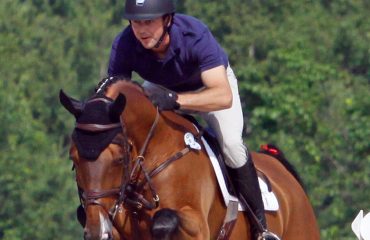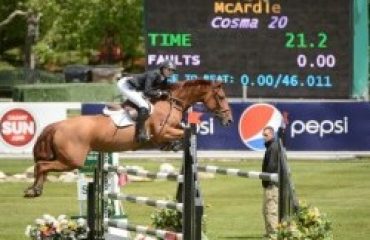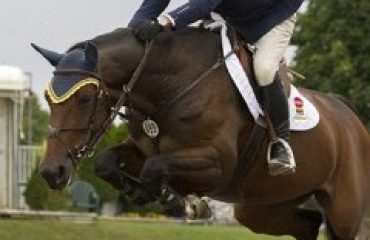by George Williams
In my columns, I try to touch on all things dressage. As in every sport, there are many different aspects, several of which I’ve discussed in previous columns. Once in a while I feel compelled to speak out about the principles of dressage training, and now is one of those times.
The FEI rulebook describes dressage in the following manner: “The object of Dressage is the development of the horse into a happy Athlete through harmonious education. As a result, it makes the Horse calm, supple, loose and flexible, but also confident, attentive and keen, thus achieving perfect understanding with the Athlete.”
There’s a lot of talk in our circles about the “Training Scale” and its importance in properly developing a good dressage horse. The Training Scale was created in Germany at a time when many of the top riders were concerned that the principles of dressage might be lost. Today, for the most part, it’s accepted around the world as the foundation for dressage as a sport as well as dressage as an art form.
At the bottom of the scale is one our most fundamental principles: rhythm. At its most basic, rhythm refers to the correct beats of a gait that make a gait pure. In other words, the four beats of the walk, two of the trot and three of the canter. At some point, we’ve all received a comment from a judge warning us that the walk we’re doing is two beats, or that we’ve sadly allowed the canter to become four-beat. Seldom, though, do we see a comment that a trot is suddenly no longer showing synchronized diagonal movement.
However, it makes sense that rhythm is first, as the training process is supposed to preserve the three correct gaits that are the essence of a good dressage horse. Rhythm — especially when you add regularity and the optimum tempo, which are all part of rhythm under the Training Scale — can produce wonderful relaxation, suppleness and looseness. In the more recent translations of the Training Scale, the word suppleness (“elasticity and freedom from anxiety”) has been used in place of relaxation. This simply reflects the difficulty of translating terms from German to English and being able to retain their understood interpretation as it applies to riding horses.
In their wisdom, the creators of the Training Scale put relaxation right after rhythm. It’s not my intent to go through the Training Scale step by step in this column. I want to jump ahead to what many consider the highlights of dressage at the Grand Prix level: piaffe, passage and pirouettes. These require collection, especially the piaffe and pirouettes, which are considered the epitome of collection. Rightly so, collection sits on the top of the Training Scale. Directly beneath it, holding it on its perch, is straightness. Ultimate straightness, the horse’s body being perfectly aligned and balanced, is crucial to collection.
The “USDF Glossary of Judging Terms” very simply defines straightness as “improved alignment and equal lateral suppleness on both reins.” It goes on to give a more detailed explanation, but one would think that between the USDF definition and the FEI description of dressage, the need for suppleness is a given and it would be universally strived for when training a dressage horse. Of course, this takes us right back to the early part of the Training Scale and begs the question: Is relaxation/suppleness being taken too lightly and skipped over?
Sadly, after years of teaching clinics and occasionally either sitting on some of the horses in the clinic or trying horses that are for sale, I find suppleness is frequently lacking. I often wonder if it’s not being taught as part of the training process, or is it just misunderstood? There’s a lot of talk about power: is the horse in front of you? All of which seems to be part of this endless quest for expression.
I remember one of my teachers, Karl Mikolka, telling me that a well-trained horse must be developed to be equal parts supple and strong. We must develop a horse to be equally as supple as it is muscled. This starts with the horse being able to stretch over the back and with correct bending on circles, through corners and on any curved line. Correct bending requires that it be throughout the whole body of the horse: from the hind leg forward to the poll, producing a suppleness that involves the three main joints of the hind leg, the body, the shoulders, the neck, the poll and that ultimately can be felt in the bit. Lateral suppleness of this quality will in turn have a tremendous effect on the longitudinal suppleness as well. If done well, you will feel the effects of it under your seat and in your hand, thereby creating a nice contact.
Leg-yielding exercises can play a huge role in developing suppleness. It would take more than just another column to cover all that can be done through leg-yielding exercises. Suffice it to say that the rider must be able to determine the angle, bend and line of any leg-yielding exercise. When riding any exercise, always ask yourself, did it have the desired effect?
Did it achieve the degree of suppleness desired? If not, it wasn’t done well enough, usually on the rider’s part. The rider needs to think about the exercise and ask themselves, what was missing? How can it be done better? Another seemingly forgotten tidbit: When the horse steps under their body with the inside hind leg, the rider should feel a lifting of the opposite shoulder. Through this we can introduce the concept of diagonal suppleness, that becomes an important part of lateral work.
In the end, we’re looking for expression in how our horses move. In my opinion, expression is the result of a perfect mix of power with suppleness where every aspect of the Training Scale is solid and in action.
Photo: Noel Williams, George’s daughter, demonstrates suppleness aboard Jasperado













